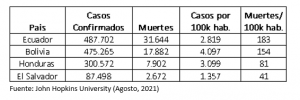More than a year has passed since the declaration of emergency health by Covid-19 and the effects are evidenced at various levels. Latin America is the most affected region in the world and in this article we explore its current situation and the challenges to face.
The current health crisis scenario, the data and projections on the economy, poverty, health care and food, among others, show how mothers and children have been particularly affected. Below, we offer some relevant data from the four countries where Fundación de Waal implements its PreNatal program: Ecuador, Bolivia, Honduras and El Salvador.
The lethality of Covid-19
According to data obtained by John Hopkins University from the beginning of the pandemic declaration until August 3, 2021, there is a total of 1,011,235 cases and 40,586 confirmed deaths in the 4 countries where the FdW operates. If we make a comparison between countries, Bolivia tops the list with 4,097 cases and 154 deaths per 100,000 inhabitants. Very closely is Ecuador with 2,819 cases and 183 deaths per 100,000 inhabitants.

One aspect of deep concern is the projection of these data to November 2021. The IHME (Institute for Health Metrics and Evaluation) estimates that significant increases in infections and lethality are expected for that month, and again, Ecuador and Bolivia would have the highest values. As projected by this organization, by November the incidence would go from 141 and 111 deaths per 100,000 inhabitants in Bolivia and Ecuador, respectively, to an estimate of 421 (Bolivia) and 586 (Ecuador). For Honduras, these projections would increase the incidence by 203 cases per 100,000 inhabitants and in El Salvador, by 105.

These figures reflect both the estimates of direct deaths from Covid-19 and the indirect ones. Excess deaths are an indicator that allows us to know the lethality of this disease, due to first and secondary causes, when comparing the number of total deaths in the years prior to the pandemic, compared to 2020, the year in which the health emergency was declared. .
Placing ourselves in the working axes of the FdW, we ask ourselves how has Covid-19 affected pregnant women, unborn babies and children during early childhood?
According to Pan American Health Organization (PAHO) “from the notification of the first cases of COVID-19 in the Americas until June 17, 2021, 231,537 pregnant women were registered positive for SARS-CoV-2 and 1,453 deaths, of pregnant women, in 29 countries and territories for which information is available ”. In this way we see that the incidence of deaths of pregnant mothers is 0.63%, out of all pregnant women infected with COVID-19, according to the data provided by the agency.
Increasing poverty
The reduction in economic activities, due to confinement, caused a decrease in family income, which translates into an increase of 3.2% in the poverty index and 1.2% of extreme poverty in relation to the year 2019 according to the data provided by the Economic Commission for Latin America (ECLAC), in the most recent edition of its Social Panorama Report for Latin America 2020 . The total number of people living in poverty now stands at 209 million and 78 million in extreme poverty.
Placing this reality in the 4 countries where the FdW implements the PreNatal program, we show that the number of poor people increased with 3.3 million and the number of people in extreme poverty with 2.1 million out of a total population of approximately 45 Millions of people.
This impoverishment of the population has a strong impact on the perspectives of childhood in the region. According to United Nations (UN) estimates, in 2020, the child population living in monetary poverty in Latin America increased by 7.6%, affecting 51.3% of this population group.
This increase is much greater than the growth for the population in general and represents an important group of children who are in danger of not reaching their full potential, due to the lack of access to the fulfillment of their fundamental rights.
An economic recovery and eventual exit from the pandemic must prioritize the most vulnerable sectors affected by the crisis, including children.
🔎 Check here ⬇️⬇️ our report THE SCENARIO OF COVID-19 IN LATIN AMERICA.
Photography Taylor Brandon on Unsplash



